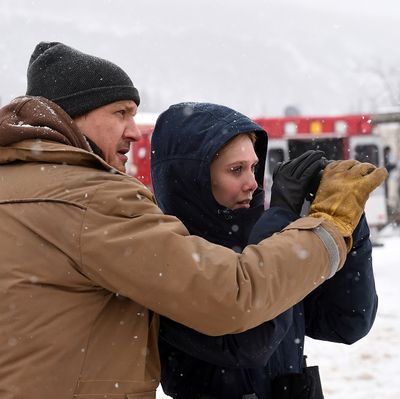
The setting of the mystery-thriller Wind River is the Wyoming reservation of the same name, where impoverished Native Americans (Northern Arapaho and Eastern Shoshone) struggle with staggering rates of crime and drug addiction. This is where Fish and Wildlife ranger Cory Lambert (Jeremy Renner) goes hunting for a big cat that has been plaguing ranchers, and finds instead the frozen body of a young Native American woman. A short time later, he accepts the offer of an inexperienced FBI agent, Jane Banner (Elizabeth Olsen), to help navigate the inhospitable countryside, with its barren wilderness and lethal cold. Lambert joins her partly because the dead young woman was the daughter of his friend, Martin (Gil Birmingham). But it’s also because he’d lost his own daughter — who was half Native American — to crime on the “res.” He’s looking for answers to her fate, too.
On the evidence of his films, Wind River’s screenwriter Taylor Sheridan has a driving social conscience, and he packs his convictions about income inequality, racism, and government overreach into bloody pulp thrillers that have a chance — small but measurable — of reaching a mainstream audience. As he was moved by stories of Texas foreclosures to write the great neo-Western Hell or High Water, he likely started Wind River after reading about a spate of brutal, unsolved killings on the same reservation. A 2012 New York Times feature by Timothy Williams chronicled both the murder epidemic and pervasive sense of hopelessness. Unemployment that year was higher than 80 percent — versus 6 percent in the rest of Wyoming. Residents could expect to live 49 years. When a Louisiana tribe got wind of Wind River, it gave Sheridan more than $10 million — 90 percent of the film’s budget.
Wind River is Sheridan’s directorial debut, and he’s still learning to think in images. He’s not a particularly judicious editor of his own material. He not only permits himself to overwrite, but he shoots what he overwrites on the nose, with none of the artful distancing of his last two directors — Denis Villeneuve, who gave Sicario a feverish palette, and David Mackenzie, who brought a classical Western grandeur to Hell or High Water. A scene in which Lambert white-man-‘splains to Martin on how to grieve for his daughter brings the film to a grinding halt — and seems bizarre, given that Martin has only just received the tragic news. As for Elizabeth Olsen, she’s capable of terrific things. She played Juliet in the worst professional Shakespeare production I’ve ever seen and was good. She’s good here, too. It’s her incongruously high-schoolish demeanor that’s the problem. Sheridan has directed the other actors to be nonplussed when they see her tromping in, as full of gumption as Tracey Flick in Election. But it’s still a painful reminder of Hollywood star-casting mandates.
The setting, fortunately, takes us back to the res, where the chill of the landscape is corrosive and the vastness seems out of scale with the dilapidated dwellings and haggard people — men and women who’ve given up hope, teenagers visibly addled by meth and opiates and the atmosphere of malign neglect. (Many of the actors are Native American, except for Graham Green, who’s Oneida — Native Canadian.) A scene in which Lambert and Banner ride a snowmobile into the wilderness to examine the young woman’s body is haunting. Lambert explains the grisly details of what happens to lungs when sucking air at that temperature. No one, he says, could expect to go far under those conditions — but this girl, he knew, went farther than anyone else. It’s a corny speech, I guess, but not against the image of the girl on the ground who seems to be still fighting for her life. A flashback to the last hours of her life begins and abruptly ends with heartbreaking swiftness.
Although the resolution to the mystery wouldn’t do credit to a third-rate thriller, it’s crazily powerful — sudden and bloody but with no real catharsis, just a sense of waste and a feeling of, “What now?” I’m not sure how Sheridan would answer that — not that an artist really needs to. He has a soft spot for vigilantism, which I’m guessing he sees as a necessary evil — or perhaps a Western genre convention that he’s loath to pass up. (Renner wears a cowboy hat.) In any case, long after the gunshots of Wind River fade, you might think you hear the cries of the dead.
*A version of this article appears in the August 7, 2017, issue of New YorkMagazine.


